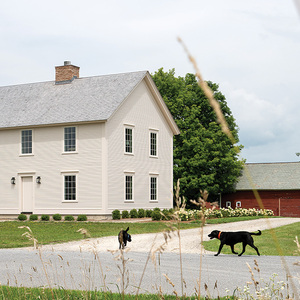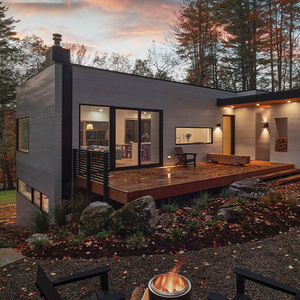*
I am finishing up the rough wiring in my kitchen addition, and am wiring for a wall mounted oven. I am running 6/3 romex for a 50 amp circuit. After reading the electrical section of the online building codes, it is stated that outlets of permanent appliances must be accessable. Fine, I run the feed to a outlet box that will be accessable from inside a cabinet. Next paragraph on appliances says all must have a disconnect, and says a plug is good except for a wall oven or cooktop. OK so what do I use? Does the code assume you are hardwiring the oven, with the wires just coming out of the wall? Any electricians here who can explain this? I planned on mounting a 4 conductor outlet in the wall, and then running the oven cord down to it. Thanks,
Dave
Discussion Forum
Discussion Forum
Up Next
Video Shorts
Featured Story

Key proposals for the next edition of the International Residential Code tackle room sizes, stair specs, emergency egress, and deck guards, among other requirements.
Featured Video
How to Install Exterior Window TrimHighlights
"I have learned so much thanks to the searchable articles on the FHB website. I can confidently say that I expect to be a life-long subscriber." - M.K.
Fine Homebuilding Magazine
- Home Group
- Antique Trader
- Arts & Crafts Homes
- Bank Note Reporter
- Cabin Life
- Cuisine at Home
- Fine Gardening
- Fine Woodworking
- Green Building Advisor
- Garden Gate
- Horticulture
- Keep Craft Alive
- Log Home Living
- Military Trader/Vehicles
- Numismatic News
- Numismaster
- Old Cars Weekly
- Old House Journal
- Period Homes
- Popular Woodworking
- Script
- ShopNotes
- Sports Collectors Digest
- Threads
- Timber Home Living
- Traditional Building
- Woodsmith
- World Coin News
- Writer's Digest


















Replies
*
Unless something is missing from the reading of the code I think the assumption is that wall mounted ovens are permanent installations (can't be slid out along the floor to get to the plug) and as such are to be hard wired. The panel breaker is the disconnect. You can run your home run wire to a covered box behind the oven and then, with an armored whip, hardwire the oven to that box and then slide the oven into its niche.
*Is this a new code change? Did you get this from an on-line National Electric Code? If so, I would like the site address.Around here we are still hardwiring the oven with the pigtail that comes attached to the appliance. It is usually a section of Greenfield ( metal flexible conduit ) with 4 conductors. You will need the specifications on the oven to know where to mount the junction box. I do not see any problem with a cord and plug on a wall oven as long as the warranty is not voided in disconnecting the factory supplied pigtail, and the plug is easily accesible inside the cabinet.But, I would check with the local inspector to see what they like to see now. Much easier to do it their way the first time instead of doing it over.Frank DuVal
*From the 1999 NEC:422-16(b)(3):Wall mounted ovens and counter-mounted cooking units complete with provisions for mounting and for making electrical connections shall be permitted to be permanently connected, or, only for ease in servicing or for installation, cord-and plug-connected. A seperable connector or a plug and receptacle combination in the supply line to an oven or cooking unit shall (1) not be installed as the disconnecting means required by Section 422-30 and (2) be approved for the temperature of the space in which it is located.Section 422-31:Disconnection of Permanently Connected Appliances(b) Appliances Rated Over 300 Volt-Amperes or 1/8 Horsepower. For permanently connected appliances rated over 300 volt-amperes or 1/8 hp, the branch circuit switch or circuit breaker shall be permitted to serve as the disconnecting means where the switch or circuit breaker is within sight from the appliance or is capable of being locked in the open position.
*This is a little off the subject, but will pay if it is your own house you are remodelling. The primary failure mode of oven elements is burnout of the internal nichrome near the terminal due to increased heating thru the contact resistance of the spade terminal that oxidizes with age. After replacing 2 elements at 5 year intervals, I brazed 250C teflon/nickel plate wire to the element, and ran that to the junction box. With this in place, the 3rd element (same manufacturer, WP) has now lasted 20 years.
*b WBA At Your ServiceArt, Do they sell 250C Teflon/Nickel Plate wire at HD ? If not where ? Do you think this would work on my range burner elements ?
*Thank you all, and Rick, thank you for typing out the code. It is very clear, obviously the site I was looking at only posted certain sections, and out of context were confusing. I will probably install the oven with a plug for "ease of service" but will use a lockout compatable 50 amp breaker at the box regardless. I have not decided which unit to buy yet, and all displays were mounted so I couldnt see the back. For hardwired installs, what do you use to connect two #6 wires together? (the flex end from the oven to the wires in the box)..Do they make wire nuts that big? Oh and is the same deal with dishwashers, are they allowed to be hardwired or usually plugged in? I plan on getting one, but have never owned one. Thanks,Dave
*Just something to think about: My electrician put the plug into the cabinet _above_ the oven rather than into the small drawer space below it. The installers were much happier with it there, rather than having to crawl on the floor to reach it.
*Check the box that the big blue wire nuts come in, most will accept 2 #6 copper wires.I personally like to put cords and plugs on the dishwasher and disposal units. I have never seen a track house wired this way... Much too costly and labor intensive.BTW, it is usually cheaper to buy a short 16/3 extension cord than to purchase 16/3 cord and a plug. Or, since these cheap SJT thermoplastic orange cords do not take abuse well and you are in need of replacing some, just buy a 50 or 75 foot and an extra male plug. Cut how many feet cord you need for an appliance and install new plug on remainder of long piece. An appliance cord for the price of a plug. As a bonus, now when the thermoplastic outer cover pulls out of the plug, you can fix it quick.Frank DuVal
*I'm putting a wall oven in my kitchen and studied theinstallation manual carefully before wiring...in mycase the specs define exactly where the junction boxshould be, including which directions the wiresshould enter. After some study I determined that this is done so that the box will not interfere withthe oven box, and so that the armored cable will drape properly as you slide the oven in.I'm still not sure how to connect the two #6 wires(line continues to the cooktop) to the smaller feederto the oven...so far the advice I've gotten has beento use a split-bolt clamp and then wrap with specialtape...this seems primitive. Does someone make aterminal block or junction that'd have decent clampslike those found on breakers, and built-in insulation?
*Primitive? This is what split bolt connectors are made for. Scotch 33+ electrical tape is fine, just use several wraps to make you feel good. It insulates at about 600 volts per layer. A high tech method is to use a hydraulic crimper and install lugs on the wires and then use regular bolts to connect, then wrap with electrical tape. Just use split bolts to begin with. Use copper plated split bolts with copper wire. Two number 6's with another wire is a little past most Blue wirenut capability, but check the box to make sure.Frank DuVal
*Frank,Is there anything wrong with using rubber tape first, then the electrical tape over a split bolt?Jerry
*There is nothing wrong with that. You can use rubber tape instead of vinyl ( black electrician's tape) or in conjunction with vinyl tape. Old timers used friction tape and rubber tape. Vinyl tape has taken over the market. Do use a good grade of vinyl, the cheaper ones seem to unwrap too easily. The rubber tape ( self vulcanizing ) usually does not come off when installed properly, as it makes a big lump of rubber.Frank DuVal
*Rather than using electrical or rubber tape has anyone used shrink tubing? Very easy to position and zap with your heat gun or hair dryer (or your propane torch if you're brave).If you've ever had to change an outlet or switch in an old house and had the insulation crack and fall off those old wires, leaving nothing but bare wire in a metal box, you'll appreciate how a length of shrink tubing will save the day and keep you from having to rewire. Attempting to wrap tape around the wires just causes more disintegration.Hey Andy, that's another tip. Send a check and don't even think of believing Adrian when he jumps in and tries to claim it is his, too.
*
I am finishing up the rough wiring in my kitchen addition, and am wiring for a wall mounted oven. I am running 6/3 romex for a 50 amp circuit. After reading the electrical section of the online building codes, it is stated that outlets of permanent appliances must be accessable. Fine, I run the feed to a outlet box that will be accessable from inside a cabinet. Next paragraph on appliances says all must have a disconnect, and says a plug is good except for a wall oven or cooktop. OK so what do I use? Does the code assume you are hardwiring the oven, with the wires just coming out of the wall? Any electricians here who can explain this? I planned on mounting a 4 conductor outlet in the wall, and then running the oven cord down to it. Thanks,
Dave